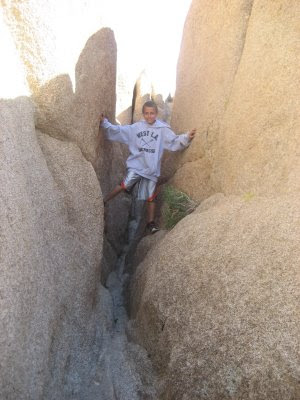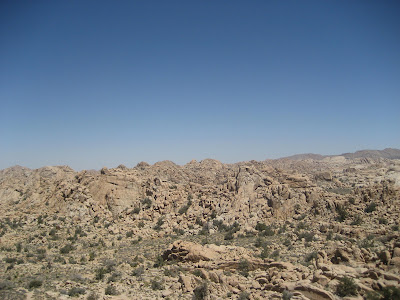 Photo by Owen Morse
Photo by Owen MorseIf you read the NWS’s discussion page they often talk how their confidence in predicting conditions is based on the consistency of the run to run model forecasts; the more consistent the runs the higher the confidence. Well, I started looking at the forecast for the desert for the weekend a whole week before and each updated run turned out to be a carbon copy of the one that preceded it, give or take a few degrees change in wind direction: Saturday 12-13k tops with east winds; Sunday 14-15k tops with somewhat stronger SE winds. The only questions leading up to the weekend was what day to fly and where. With the east wind picking Blackhawk for Saturday seemed to be a no brainer. Despite the predicted higher tops Sunday would be a tougher call. With a moderately strong SE wind there would be an outside chance that it would be blowing down at Blackhawk – although as I have said in the past, no matter the wind direction it just always seems to blow upslope there. Crestline had great potential, but one always runs the risk of getting stuck below an inversion on the frontrange. A SE wind is generally a cure for that, but the lower level stuff was predicted to be out of the west. That left Laguna Mountain near San Diego. In the beginning of the week Laguna looked like the place to go, but as we got closer to Sunday, I wasn’t all that excited about what I was seeing: 9-10k tops with 15-20 knot winds. In the end it was decided that Blackhawk on Saturday would be the safest call. Besides, a great day equals a late return home; Saturday night would be much better than Sunday.
I met Bruce Barmakian at his house along with Owen Morse, Chris Van Veldon and Wally our driver before heading out to Hesperia to have breakfast with Tony Deleo and Herb Seidenberg before heading up the hill. The early morning winds on the desert floor were light out of the west but it was definitely east at launch. Clouds started to form above Big Bear at around 11:00. We started piling off of launch at a little after noon with Tony leading the way.
I think I have mentioned this before but it bears repeating: at most mountain sites it’s probably a good idea to try to hold the high ground for as long as possible if you’re not climbing out; Blackhawk is not one of them. If you’re not climbing then head out. There is usually a house thermal that sets up just beyond the front points and you want to make sure that you have ample altitude to search around for it. Except for Chris, everyone had to rely on the house thermal out front in order to get up and out on course. Only Owen and I didn’t connect. Both of us were forced to turn down wind low. Needless to say, skimming the tops of Joshua trees wasn’t what I had in mind when I was looking at that beautiful forecast all week. Of course, if there wasn’t a “however” you would be still looking at a picture of the pie covered faces of my daughter and her friend Sarah.

Down below 5k just before the 18 I lucked into a low leaner. By the time that I finished circling I was ten miles from launch and still in the ballgame. Owen, after reporting that he was about to land, managed to find something too - although I'm not sure where. Chris, who is fairly new to cross-country flying, on the other hand, managed to get up at launch and get ahead of us --but not as far ahead as he was reporting on the radio. Apparently his GPS was set in kilometers; before we figured that out he had both Owen and I thinking, “Who is this guy?”

Even though I managed to get back in it my maximum heights at that point were about 2k below what everyone else was reporting on the radio. I had picked up my low leaner at the base of the foothills just NE of the Mitsubishi cement plant and had kept that same position relative to the mountains on my way to Ord. Up ahead just short of Ord I could see Owen flushing out of the foothills low toward Apple Valley. I crossed above his flight path by about 2,000 ft, but when I saw him eventually start turning circles, I decided to angle back into the wind to join him. With such a uniform surface in the desert the thermals tend to be far and few between; I thought it be wiser to turn back into the wind for a sure thing rather than continue on. The decision paid off as both of us eventually had a climb out to 10k as we drifted past the north face of Ord. At about the same time Chris was hitting the deck near the Mojave River wash. Bruce on the other hand, managed to make his way over to a line of clouds set up along the north side of Victorville and was reporting climbs to 13k. Tony? No clue. Due to radio problems and no cell phone we would not here from him again until we were on our way home at the end of the day. And that’s all I’m going to say about that.
From Ord and with Owen in tow I headed straight down Main Street in Hesperia where I had another climb to just over 10k above the Sante Fe RR tracks. With the cloud street to the north I was worried that we might be on the wrong side of the convergence, but when I looked head across the 15 I saw a dust devil doing its thing right down Phelan Rd. I had plenty of height to fly in above it comfortably. Or so I thought. After crossing the 15 I started sinking like a stone and the dust devil suddenly started moving steadily away from my glide path. Thinking that the lift was out of reach I was surprised to hear the vario start beeping. And it continued to beep all the way to 15,000 ft, my highest climb of the flight.

The whole episode was rather intriguing: I was just a few hundred yards upwind of the dust devil and below the top of it when I found the lift. As I started to climb out Owen came in low from a slightly different direction that put him downwind of my drift angle, but still managed to find something. I guess the only explanation is that the dust devil was the remnants of the last thermal and we arrived in time to catch the beginning life of a massive new one.


Regardless, by the time I finished climbing out I was directly over Rte 138 on my way to a cloud forming near the Crystal Air glider port. The cloud dissipated by the time I arrived, but I found something over the town of Pearblossom for another climb to the mid 13s. And it was a cake walk from that point on.

I reached 15k again just on the west side of Lake Palmdale -- I briefly considered copping a glide to Kagel – and had another climb in Owens Valley strength lift to the mid 13s right above Lake Hughes. At Lake Hughes with 100 miles about to click over on my GPS and suffering from back pain along with the usual stuff, I decided to call Interstate 5 goal. Bruce had already made the connection above Frazier, and Owen had decided to fly out to Kagel. He arrived at 11k so he continued west as far as possible in order to get his first 100 mile flight. He ended up putting it down near Magic Mountain for 104 miles.
From Lake Hughes on the air was very buoyant; I had plenty of opportunities to stop to climb out in an attempt to get high enough to get atop Frazier, especially above Booster Junction where the 138 runs into the highway, but I was ready to land. Instead I just used the lift to extend my glide to Gorman...where I proceeded to get caught downwind while landing and taking out a carbon fiber base tube. The flags in Gorman were all flapping north (south wind) when I arrived. And it was still blowing south when I dropped down into the LZ on final. That is until about half-way through when I suddenly started to pick up speed. After dusting myself off I looked over at the flags flapping south.
Bruce would go on to the base of Plowshare Peak for 183 miles and a new RW record. Or so we thought. Tony finally managed to check in to indicate that he landed up the road at 204 miles.
Distance: 120.04 miles
Duration: 3:55 hours
Max Altitude: 15,097 ft.


































 West Divide; Whiteledge out in the distance
West Divide; Whiteledge out in the distance East Divide
East Divide
 Coming up to Nordoff Ridge
Coming up to Nordoff Ridge Dean making the glide to Twin Peaks
Dean making the glide to Twin Peaks Boyds, Puckers and then Santa Paula Ridge in the distance.
Boyds, Puckers and then Santa Paula Ridge in the distance. The Rocky Bluffs
The Rocky Bluffs



